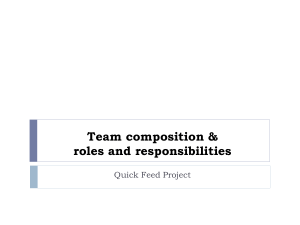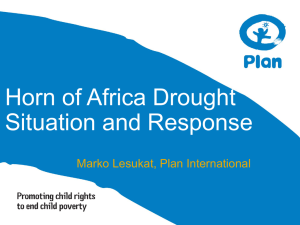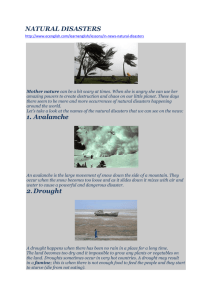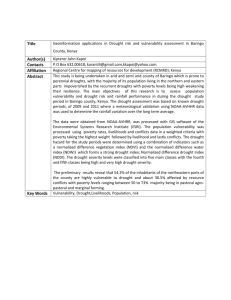Case Study (Drought)
advertisement
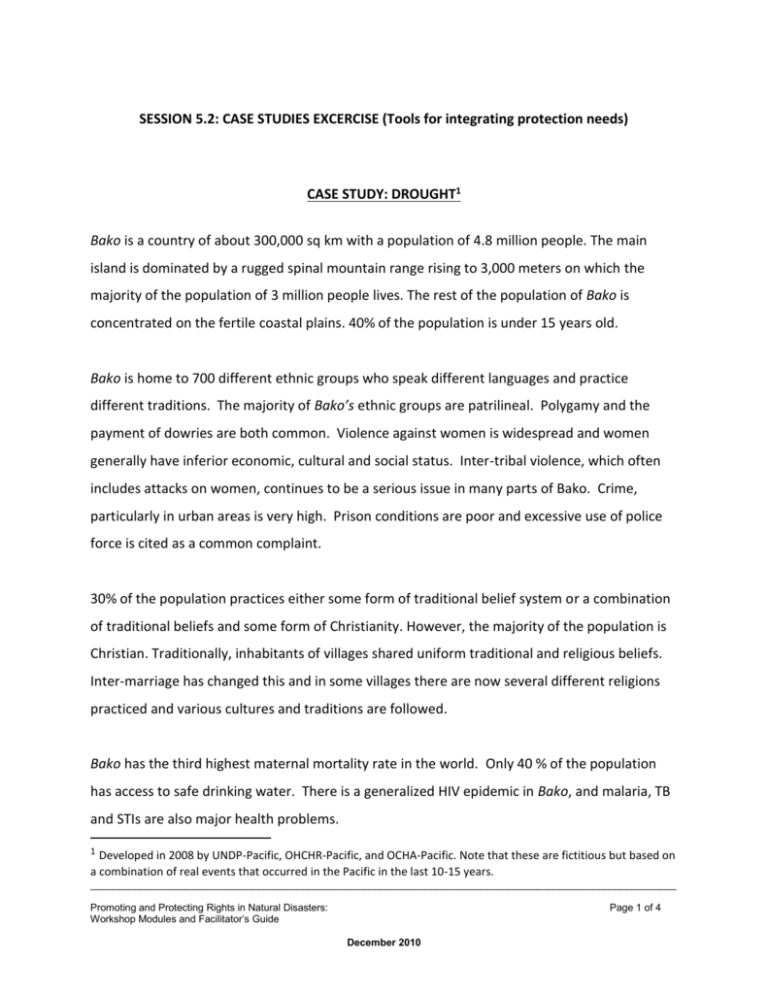
SESSION 5.2: CASE STUDIES EXCERCISE (Tools for integrating protection needs) CASE STUDY: DROUGHT1 Bako is a country of about 300,000 sq km with a population of 4.8 million people. The main island is dominated by a rugged spinal mountain range rising to 3,000 meters on which the majority of the population of 3 million people lives. The rest of the population of Bako is concentrated on the fertile coastal plains. 40% of the population is under 15 years old. Bako is home to 700 different ethnic groups who speak different languages and practice different traditions. The majority of Bako’s ethnic groups are patrilineal. Polygamy and the payment of dowries are both common. Violence against women is widespread and women generally have inferior economic, cultural and social status. Inter-tribal violence, which often includes attacks on women, continues to be a serious issue in many parts of Bako. Crime, particularly in urban areas is very high. Prison conditions are poor and excessive use of police force is cited as a common complaint. 30% of the population practices either some form of traditional belief system or a combination of traditional beliefs and some form of Christianity. However, the majority of the population is Christian. Traditionally, inhabitants of villages shared uniform traditional and religious beliefs. Inter-marriage has changed this and in some villages there are now several different religions practiced and various cultures and traditions are followed. Bako has the third highest maternal mortality rate in the world. Only 40 % of the population has access to safe drinking water. There is a generalized HIV epidemic in Bako, and malaria, TB and STIs are also major health problems. 1 Developed in 2008 by UNDP-Pacific, OHCHR-Pacific, and OCHA-Pacific. Note that these are fictitious but based on a combination of real events that occurred in the Pacific in the last 10-15 years. _________________________________________________________________________________________________________ Promoting and Protecting Rights in Natural Disasters: Workshop Modules and Facilitator’s Guide Page 1 of 4 December 2010 85% of the population engages in subsistence farming. Mining of gold and copper by multinational companies are the leading industries in Bako. Two of the 3 mines in Bako are found in the mountainous areas of the main island. Corruption is described as endemic. In December 2010, it was reported that almost no rain had fallen in Bako since the beginning of the same year. The worst affected regions had been the mainland provinces of Olsem, Strait and Nomo, in which also the main towns of the island are located. Almost the entire population still relies on open sources, especially wells and streams, for water supply. Only communities in the immediate surroundings of the three mines had access to water catchment tanks. Fires had devastated extensive areas of grassland, forest, plantations and farmland and the haze had at times restricted aviation. To compound the problem, in the mountainous areas above 2,000 meters, a prolonged series of nightly frosts were reported, which in combination with the drought had destroyed cash crops and staple food. In the worst affected areas the entire crop had been destroyed. Because of the drought, approximately 80% of Bako’s total population is now reliant on unfamiliar water sources, usually the larger (and also more polluted) rivers. Community health care and education have been affected, with health centres, aid posts and many rural schools closed due to lack of water. Fires have devastated large areas and the main hospitals in Olsem and Nomo had been partially destroyed as a result of a bushfire. The hospital in Strait reports overcrowding. Overall, some 500,000 people now have very limited access to food and restricted access to safe water. Health consequences of this are becoming more apparent, with increasing incidences of eye infections, skin disease and diarrhea, and strong anecdotal evidence of deaths amongst those who would not normally be considered vulnerable. _________________________________________________________________________________________________________ Promoting and Protecting Rights in Natural Disasters: Workshop Modules and Facilitator’s Guide Page 2 of 4 December 2010 As the drought continues, the number of people in need of food aid grows with each passing month. Even if widespread heavy rain would fall soon, and subsistence farmers were able to plant seedlings, the first crops would not be ready for consumption for another four months. However, most seedlings in the mountainous areas have been consumed, and if rain comes, large quantities of seed materials will be needed in the affected areas. If no rain falls the country will enter the next dry season (May to October), and food aid for increasing numbers will be needed throughout the next year. Migration from the rural to the urban areas is already perceptible. The drought is damaging not only subsistence farming but also the production of cash crops such as coffee. More significantly for the national economy, two of the mines have had to close as the level of water has dropped in the rivers on which they depend for supplies and the transport of ore. There are three main hydro-electric catchment-areas in Bako and all are less than half full. The main highway is useable but there are significant safety issues associated with traveling on the highway. It has been reported that many women have been assaulted, attacked and in some cases raped by the roadside as they carried water/food back to their families. Inter-tribal fighting has increased. Two children were found dead by the roadside last month. The already high levels of maternal mortality have increased, as have rates if infant mortality. There are reports that increasing numbers of women and girls are engaged in sex work, including transactional sex for food for themselves and their families. Because of internal parliamentary problems between the various political parties the parliament failed to pass a bill to create designated funds for drought relief efforts. The governors from the three provinces belong to three different ethnic groups as well as different political parties. The provincial responses have focused on the highest populated areas where _________________________________________________________________________________________________________ Promoting and Protecting Rights in Natural Disasters: Workshop Modules and Facilitator’s Guide Page 3 of 4 December 2010 the three governors have their political stronghold. Government services, including health services, are partially functioning in the three most affected mountainous provinces. The villages themselves have started selling limited assets and are buying canned foods and rice. Availability of coconuts has decreased as people substitute drinking water with coconuts and other plants. There has also been some assistance from the donor community, international organizations, and NGOs. Coordination between donors, international organizations and the government proofed difficult. Because of coordination issues and logistical challenges most relief goods were stockpiled in the capital of Bako, with only few resources going directly to the affected areas. A logistical supply center for the distribution of food and water has been developed in Olsem, but efforts of aid workers have been hampered by transportation difficulties. Several truckloads of rice and other food staples have been hijacked while traveling on the main highway to the most affected mountainous areas. _________________________________________________________________________________________________________ Promoting and Protecting Rights in Natural Disasters: Workshop Modules and Facilitator’s Guide Page 4 of 4 December 2010

